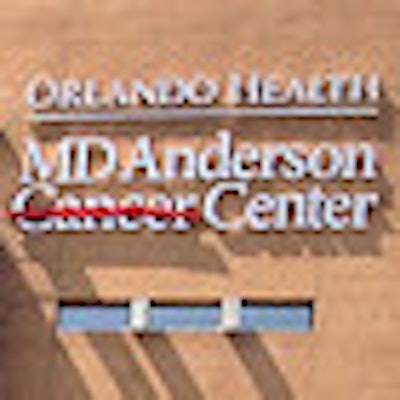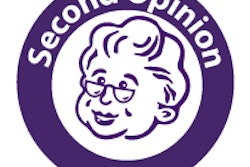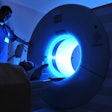
A little more than a year after a Florida cancer care hospital took the plunge into low-dose CT lung cancer screening, the program has proved its worth, according to the physicians who are running it -- though they admit they wouldn't mind having a few more people to screen.
Thoracic surgeon Dr. Luis Herrera, of MD Anderson Cancer Center Orlando, said he was so excited about the results from the National Lung Screening Trial (NLST) in 2011, showing a 20% decrease in mortality for smokers who got screened, that he wanted to start screening right away. It didn't take long. By November 2011, the program was ready for its first patients.
 Dr. Luis Herrera, section head of thoracic surgery at MD Anderson Orlando. All images courtesy of MD Anderson.
Dr. Luis Herrera, section head of thoracic surgery at MD Anderson Orlando. All images courtesy of MD Anderson."We saw that the data were powerful enough to do this and we started a pilot project," said Herrera, who is section head of thoracic surgery at MD Anderson Orlando. "We wanted to make sure it wasn't too cumbersome, make sure people weren't going to fall through the cracks, and hopefully detect some abnormalities or early lung cancers."
Quick start, slow progress
One year in, only about 50 patients have been screened, but three lung cancers have been detected among them. For those patients, who are alive and undergoing care today, it has certainly been useful, he said.
"We had good momentum early on in terms of making people aware of the program," Herrera said. "We haven't marketed it or made people aware as aggressively as one could, but we've made a couple of informational pamphlets available on our website."
The main problem has been the lack of buy-in among referring physicians, Herrera said. "I think that will change as [CT screening] becomes a more accepted standard of care," and even though several medical societies such as the American Cancer Society have embraced screening, "it's still not part of the armamentarium of most physicians."
The people who have come in for screening -- "mostly well-educated patients who want to take care of their health," Herrera said -- have done so of their own accord. And the patient numbers are small despite a low flat rate of $375 per initial screen; the center absorbs the rest of the cost of the initial scan (about $1,500), although it does charge another $375 for each follow-up scan. When there are suspicious findings, the screening service goes into diagnostic mode and at that point usually gets help from insurance providers to follow up patients.
How it works
The hospital employs a screening coordinator who works directly with the rest of the program staff and checks the screening criteria for individual candidates. The hospital also makes the coordinator's direct phone number available to primary care physicians.
MD Anderson Orlando currently uses two 64-detector-row CT scanners for the program (Aquilion, Toshiba America Medical Systems; Somatom Sensation, Siemens Healthcare). These have the capacity to at least double the screening volume and examine several more patients a day, Herrera said.
 Thoracic surgeon Dr. Theolyn Price meets with screening patient Richard Phillips as part of the lung cancer screening program.
Thoracic surgeon Dr. Theolyn Price meets with screening patient Richard Phillips as part of the lung cancer screening program.Soon after arrival at the hospital, the screening candidate is evaluated by nurse practitioners or other team members who ensure that he or she meets the screening criteria. The patient is then scanned and the results are explained to him or her in short order by a thoracic oncologist. A spreadsheet program is used to schedule follow-up appointments, and the screening coordinator calls when it's time for another visit, Herrera said.
The whole screening process takes place in a day, though it can be completed in as little as two hours under optimal circumstances, said hospital spokesperson Katie Dagenais. Currently, a month's worth of screening scans (typically five or six so far) are scheduled for the same day of the month to line up the resources efficiently.
"It takes a lot of coordination, both on our clinic side ... and with the radiology group, to coordinate the schedules so that we can do it all in one day -- and get people's answers on the same day," she said. "We try to minimize the time between them getting on the table and getting the results."
The CT scanning protocols were set up a year ago, in collaboration with Siemens and Toshiba, and referenced to the International Early Lung Cancer Action Program (I-ELCAP) protocols.
Sorting out candidates
The program follows the same criteria as NLST in terms of risk factors: ages 55 to 74, with a history of 30 pack-years or more. Current smokers can be scanned; quitters must have done so within the past 15 years. If no abnormalities are found, the hospital usually recommends that they come back to repeat the scan once a year for two additional years. After the two additional years, screening ends if no abnormalities are found.
However, Herrera believes that stopping screening after three years without an abnormality might not be the best approach.
"If you look at [NLST] carefully, a lot of patients in the CT screening group developed cancer after they stopped screening -- within the next five years -- and those cancers were not early stage," he said. "So doing three years and then stopping, or going back to a chest x-ray, may not be enough for this high-risk group."
"We haven't crossed that bridge yet, but our sense is that in an ideal world we'll screen once a year while the patient is at risk," he said. "I think many more lives would have been saved had [NLST] continued with CT screening for more than three years."
As a result, Herrera sides with the American Cancer Society's view that screening should continue beyond three years, though the financial burden on the patient from unlimited annual screening demands a more finely tuned solution than is available today for selecting screening subjects.
Better patient-selection tools will also help curb a central criticism of screening: that it might be picking up indolent cancer that would never have harmed the patient. But plenty of questions remain unanswered about lung cancer screening, particularly regarding how to deal with abnormal scans.
One in four patients has a nodule, but most are benign. The Orlando team applies NLST criteria to define a positive scan (noncalcified nodules 6 mm or larger), and follows Fleischner Society guidelines for the management of suspicious nodules:
- 4 mm or smaller = diagnostic CT at 12 months
- 5-6 mm = diagnostic CT at 6-12 months, then at 18-24 months if no change
- 7-8 mm = diagnostic CT at 3-6 months, then repeat imaging at 9-12 months and 24 months if no change
- Larger than 8 mm = evaluation now with PET and/or biopsy (or diagnostic CT at 3, 9, and 24 months)
Most patients have required only follow-up imaging, Herrera said. Among the first 50 patients, three were eventually diagnosed with lung cancer.
"Two were obvious and in advanced stages; a third had a very small nodule that was followed every six months for 12 months, and over that time the nodule grew enough to be concerning," he said. "We did surgery on that patient, and she had a 7-mm non-small cell lung cancer, so she basically got diagnosed and treated at a very early stage, which is the ideal scenario."
The non-small cell lung cancer patient underwent successful resection last fall, has quit smoking, and today is doing very well, Herrera said. The two patients with large tumors, who were also completely asymptomatic at presentation, are currently undergoing chemotherapy and radiation for locally advanced disease, he said.
 |
| MD Anderson Cancer Center Orlando. |
Some don't qualify
The center does turn people away who don't fit the NLST criteria, like the 84-year-old man who showed up last month. Herrera said they had a good discussion, and he explained that actual risk is unknown for someone his age.
"The most important risk is finding a nodule that is not cancer but creates enough alarm to require invasive testing, so you want to minimize invasive procedures," Herrera said. The patient eventually settled for a chest x-ray, which was normal, he said.
Other patients claim to fit the criteria, but when you really sit down with them, they'll admit they quit for a long time before starting again, so they're closer to 15 or 20 rather than 30 pack-years.
"We try to push them away from screening because we really don't know the benefit in someone who is lower risk than the NLST," he said.
For those who don't match the guidelines, "the risk of finding cancer is lower, but the risk of radiation or the risk of false positives is still the same, so the risk-benefit ratio starts to become unfavorable," he said. "Is it still worth screening them?"
Marketing the program
For now, the center has decided against launching an intensive marketing program in favor of a low-key approach. Quite simply, it seems wiser to provide high-quality information to patients and let them decide, rather than relentlessly try to persuade individuals to get screened, Herrera said.
A YouTube video promoting MD Anderson Orlando's screening program is available here.
MD Anderson diagnostic radiologist Dr. David Harding told AuntMinnie.com that the program has set itself apart from centers that offer little more than CT scans, adopting a comprehensive approach that he believes will serve MD Anderson well over the long term.
"As reports continue to come out from national and international sources that show the value of doing this ... more and more people will start asking about this," Harding said. While centers offering only imaging are common, "we've gone about it a little bit differently in having it tied into consultation with thoracic surgery, smoking cessation, and imaging," he said.
High volumes or no, MD Anderson is in lung cancer screening to stay, Herrera predicted.
"I think it's a good service, and we're in it for the long haul," Herrera said. "We think it's worth providing the service as long as we can provide adequate follow-up and guidance to our patients. We do hope to see the numbers increase; hopefully it will make more of a positive impact on patients' lives by potentially detecting this disease earlier and also helping them modify their lifestyle."



















